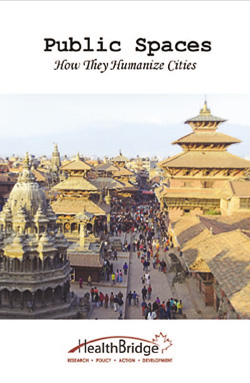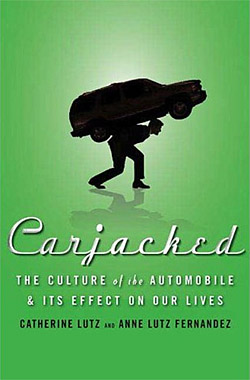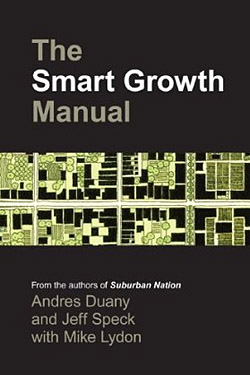
|
||
|
Issue 57 |
|
8 March 2010 |
|
 Salzburg, Austria A café in the old town. ©2002 J.Crawford AnnouncementsThe BooksCarfree Design Manual received a full review from Todd Litman of Victoria Transport Policy Institute on Planetizen. The book is now widely available in Europe and North America. Any bookseller in the English-speaking world should be able to order it. Carfree Cities is still widely available in paperback. The hardcover edition is now out of print.World Carfree NetworkCarfree.com actively supports World Carfree Network [WCN]. They send the following news:Towards Carfree Cities IX to be hosted in YorkYork, located about midway between London and Edinburgh, will host Towards Carfree Cities IX between 28 June and 1 July 2010. I will be one of the keynote speakers and will also offer a workshop on in-the-field design of carfree areas. I am looking forward to this year's conference, which is being organized by an experienced and committed group of volunteers.Carbusters Now On-LineWCN is releasing a new, on-line version of the venerable Carbusters. Have a look at the Carbusters.org web site. More of the magazine's content is now available on line.
|
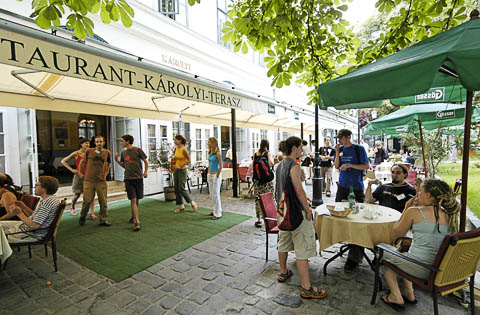 Budapest This friendly city has many fine outdoor cafés. ©2005 J.Crawford CafésWe continue the "sidewalk cafés of Europe" theme in this issue. Photographs I have taken of cafés around Europe are scattered throughout this issue.CONTEST: Who can figure out the difference between the photographs in this issue and those in the last issue?
News Bits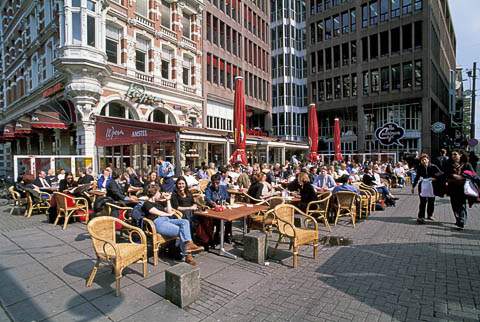 Rembrandtplein, Amsterdam One of several large outdoor cafés on this important square. ©1999 J.Crawford Copenhagen and ClimategateWe won't have anything further to say about the disaster in Copenhagen last December. The revolting news has been so thoroughly covered in the mainstream media that we have nothing to add.Likewise, the tempest in a teapot being called "Climategate" is not worthy of further coverage, either. A few people made some mistakes that don't affect the overall conclusion that the world's climate is teetering on the brink of disaster. The right-wing-nuts are seizing on these errors as if they are evidence of malfeasance and proof that climate change is just a figment of someone's imagination. Nothing will change their opinion except future events, and by then it will be too late.
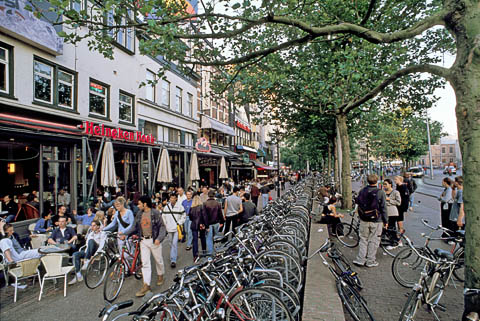 Leidseplein, Amsterdam Although not the largest square, the Leidseplein is the city's most lively. ©1999 J.Crawford Carfree FazilkaFazilka, a small city in India's Punjab, has become the first city in the region to adopt the carfree city concept. The market center has been made carfree during day-time hours. The city has a history of supporting non-motorized transport. This is a sensible approach in Indian cities, where as much as 80% of air pollution arises from motorized vehicles.Last year a one-week "Fazilka Heritage Festival" was held, during which the center city was made carfree. A study revealed that during the trial, social life, law and order, air quality, and road safety all improved. A local new report concludes: Communities that are NMV-friendly are seen as places with a high quality of life in the society. NMV-friendly communities are places where people feel safe and comfortable riding their cycles and walking for fun, fitness, and transportation. Encouraging NMV is a simple way towards improving public health. With more people joining NMV, communities experience reduced traffic demands, improved air quality and greater physical fitness. In addition, NMV-friendly towns are often seen as most safe place to live.The city supports continued use of the traditional pedal rickshaw and has added a Dial-a Rickshaw service. The politicians behind these initiatives are enjoying broad support, which has been seen in places as diverse as Bogotá, Zurich, and Seoul.
"View Point: 'Car-free city' concept in Fazilka"
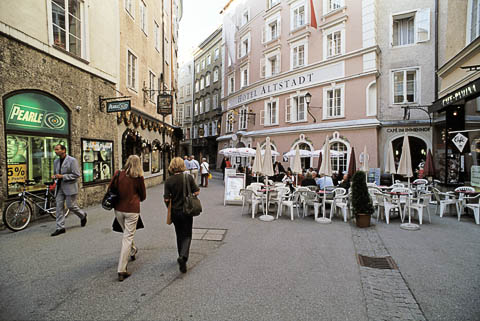 Salzburg The old town is a network of narrow streets and small squares. ©2002 J.Crawford Obama and Sustainable CommunitiesThis is an excerpted version of a recent EPA press release:U.S. Housing and Urban Development (HUD) Secretary Shaun Donovan and DoT Secretary Ray LaHood will address the 9th Annual New Partners for Smart Growth Conference. They will be joined by EPA Assistant Administrator Mathy Stanislaus.Two additional links are now broken. I am not certain how seriously this initiative should be taken, but it goes in the right general direction, if not to the carfree final destination. It might be worth making inquiries at the new Office of Livable Communities to see if there is any funding available for carfree conversions or new development.
Original press release: "Top Obama Administration Officials to Promote 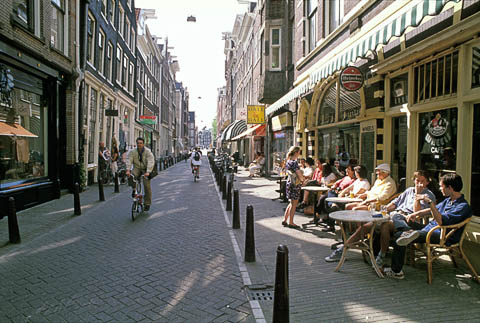 Amsterdam Normally-chilly Amsterdam moves outdoors at the first hint of warm sun. ©1998 J.Crawford GIS and InfillGeographic Information Systems (GIS) bring the power of the computer to the manipulation of digital geographic information. The technology is maturing and starting to offer useful ways to look at the world around us, particularly the parts that we have built ourselves.GIS now allows planners to examine and plan space use at practically any level of detail. It can be used to identify spaces that are unused, underutilized, or misallocated. In San Francisco, more than 1600 such parcels were identified. They have a total area about half the size of the city's large Golden Gate Park. These sites are commonly neglected because they are revenue-neutral and don't appear on anyone's balance sheet. Academics at the University of California, Berkeley, have developed a project called Local Code, which identifies unused paved space in urban areas. Finding useful ways to employ this space can greatly improve the social, economic, and environmental health of the surrounding areas. The system also allows users to identify physical and ecological problems such as storm-water remediation and heat-island effects. Social and medical problems such as incidence of crime or risk for respiratory ailments can be visualized. Even small patches of available space can be quickly identified, a task that formerly required lengthy field investigations. Local Code helps to identify and green-up excess space for use by the public. These spaces are today not only misused, they are often eyesores (commonly in the vicinity of highways) that blight neighborhoods. The most remarkable thing about Local Code is that it analyzes data on buildings, sewer location, topography, and so forth in order to assist optimum design for each site. The results are remarkably detailed and specific. Micro-climate is considered by the software, and the solution is intended to make the space attractive to users while also solving local and regional problems. The proponents speak of "data-driven design." This conforms to long-standing site planning practices, although the data can now be assembled far more quickly and easily than formerly. One problem to watch, of course, is that automated solutions to human problems are not immediately adopted without community review. "Data-visualization capabilities can't solve all the problems, but it's hard to overestimate the extent to which this information can help us to think about larger systems and their interrelationships, so that we see a building as not just a building but an ecological infrastructure." The original article is worth consulting, as it includes a number of informative graphics, some of which are very detailed if clicked on.
"Space: Itís Still a Frontier" 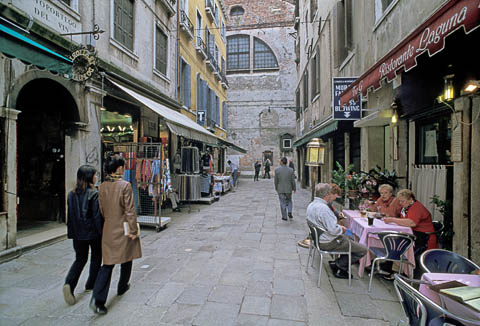 Venice A small café integrated into a local commercial street. ©2001 J.Crawford Health and TransitWhat is being called "mass active travel" is the subject of a major study which claims "Pedestrians and cyclists should be made king of the urban jungle." I myself don't see it as a jungle, but the rest seems reasonable.Money should be reallocated to make walking and biking "the most direct, convenient, and pleasant options for most urban trips." This includes giving them priority over motorized transport at intersections. The British medical journal The Lancet recently published six reports on the health benefits of strategies to halt climate change. The study authors see the need for "enormous" changes to combat global warming, changes that will also be good for people's health. Millions of deaths could be avoided by these changes. Simply encouraging walking and biking would bring large benefits for both human health and the climate. "Green" cars are not seen as part of the solution. They call for motor vehicle speeds to be limited and tightly controlled, with non-motorized modes taking priority.
"Walking, biking good for you and the planet: Study"
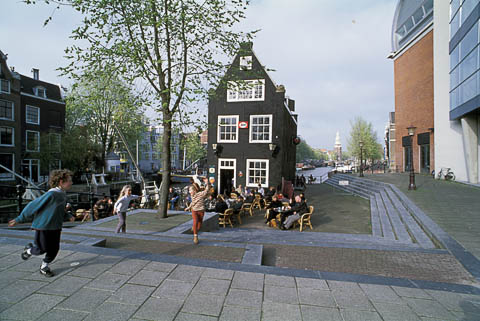 Amsterdam A small café on a local square. ©1999 J.Crawford Slow Down, Save KidsA new study in the British Medical Journal confirms the obvious: lower urban speed limits save lives. Many lives, especially children.Zones where speed limits are lowered to 20 MPH cut road injuries by 40%. The number of children killed or seriously injured was cut by half over the past 15 years. The study, from the London School of Hygiene and Tropical Medicine, estimates that 20 MPH zones could prevent up to 700 casualties in London alone. At 20 MPH, nearly all pedestrians struck by a car will survive. At 30 MPH, one in five will die. This appears to have been an exhaustive study based on data collected over a 20-year period. The researchers concluded that the introduction of 20 MPH zones is associated with a 41.9% drop in casualties. The greatest reduction is among children younger than 11. Injuries to cyclists fell by 17%, and injuries to pedestrians fell by almost a third. There was no evidence that the reductions were associated with higher casualty rates in nearby areas to which traffic might have been displaced. In fact, casualties in adjacent areas fell by an average of 8%. It was estimated that 20 MPH zones in London now save 200 lives a year. This would increase to 700 if plans to extend the zones were implemented. A similar study by the Department of Transport had reached approximately the same conclusions.
" 20mph speed zones cut road injuries by 40%, study says"
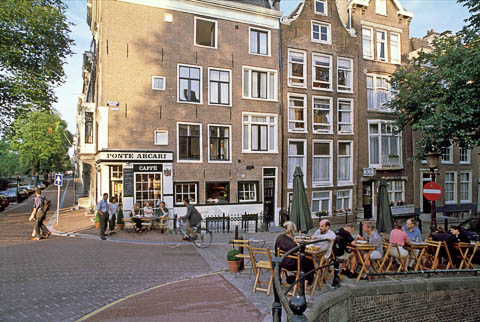 Amsterdam A small café along the edge of one of the central canals. ©1999 J.Crawford Getting it Wrong in AmsterdamAmsterdam, the world's preeminent biking city, has lost its way. Until recently, the policy in the city center has been to discourage driving and promote biking. This was a sensible approach in this old city of narrow streets.Now, however, the city has begun an aggressive campaign to get people to buy electric cars. The city council is giving away power for electric car owners for two years. Worse, the city will pay half of the extra cost for a plug-in vehicle. Favorable parking treatment is also under consideration. The city wants 10,000 electric cars by 2015 and 40,000 by 2020. By 2040, all cars should be electric. Electric cars are seen as crucial to the city's goal of a 40% reduction in greenhouse gases by 2025. At present 38% of transport in the city is by bicycle, compared to 37% percent by car. In the city center, however, cycling accounts for 55% of movements. Many cyclists are afraid that electric cars will reduce the number of cyclists and make cycling more dangerous. And they say, "We think the cleanest means of transport is the bike. Definitely." Ria Hilhorst, Amsterdam's cycling official, says, "I think it [bicycling] is the future way of transport. It's very fast. You can go anywhere. It keeps cities livable and safe." One cyclist said, "It's better if there are no cars."
"A Pro-Bicycle City Faces Trouble Promoting Electric Cars"
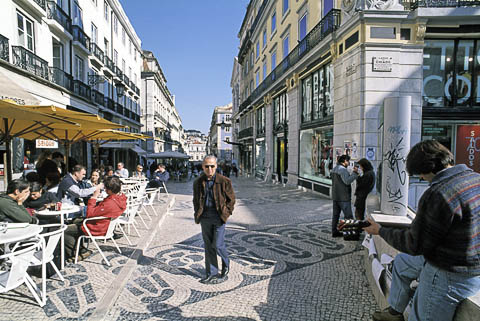 Lisbon Lisbon is one of Europe's most overlooked cities. It's full of cafés. ©2003 J.Crawford Road Taxes vs. Road ExpendituresThe Texas Department of Transportation republished an earlier study that confirms the general wisdom: roads are very expensive. This comes from a pro-pavement DoT that now admits that the capital costs for design, construction, and maintenance of roads far exceeds the total tax receipts allocated for highways.The study estimated that gasoline taxes would have to be raised six-fold to bring revenue in line with expenditures. The cost of gasoline (currently $2.50/gallon) would have to rise to $4.35. "Green" cars are seen as a problem in themselves. Their lower demand for fuel will actually exacerbate the highway budget crisis. The study revealed that no road pays for itself in gas taxes and fees. For example, in Houston, the 15 miles of SH 99 from I-10 to US 290 will cost $1 billion to build and maintain over its lifetime, while only generating $162 million in gas taxes. That gives a tax gap ratio of .16, which means that the real gas tax rate people would need to pay on this segment of road to completely pay for it would be $2.22 per gallon.None of this is news, but it's interesting to see the truth seeping out in a state such as Texas.
"TxDot's newsletter"
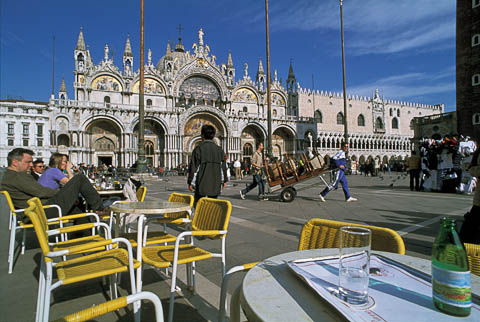 Piazza San Marco, Venice I think it's the best public square in the world. ©2001 J.Crawford The Biomass DisasterObama has announced measures to meet the mandate for biofuels that was enacted as part of the Energy Independence and Security Act in 2007. The plan calls for 36 billion gallons of annual bio-fuel production by 2022. It grants support, through the USDA, for the cutting, harvesting, and transport of biomass to produce "renewable" electricity and heat.The policy has been adopted without an understanding of its impacts on food production, public health, land use, greenhouse gas emissions, soil conservation, water consumption, or biodiversity. Since the law was enacted, the critique of biofuels, corn-based ethanol in particular, has grown steadily more damning. Cellulosic fuels would, in theory, answer some of the concerns because they are made from the inedible parts of plants. Serious problems have beset cellulosic fuel production, however. Furthermore, farmers are reluctant to see their chaff go off to a distant refinery, never to return. They need this material in their soil. Simply burning biomass for electricity and heat is easy. Communities are offered "green jobs" cutting, hauling, and chipping their forests to fire a new generation power plants being constructed (or retrofitted). At least 200 new burners are proposed in the USA. Some coal-fired plants may use biomass under the assumption that burning trees is better than burning coal. To produce one continuous megawatt (MW) of electricity requires the burning of approximately 13,000 tons of wood per year. The wood chips would be delivered by diesel-fueled trucks. Remember that one megawatt is not a lot of power; it's generally considered enough to "power a thousand homes." Most power plants produce peak outputs of 500 MW, and the nukes are run continuously at full power (when they're not down for refueling or safety problems). The US EIA says that the USA generated 4,348,856 Gigawatt-hours (GWh) of electricity in 2007. Your 13,000 tons of trees produces only 8,760 GWh. If the USA were to produce just 10% of its electricity by burning biomass, 760 million tons of wood would be required each year. This translates to harvesting an area the size of Florida every year. (This is not clear-cutting, but selective cutting at a rate of 20 tons/acre/year.) One way to meet the demand is to replace indigenous forests with eucalyptus plantations. They prefer a genetically-modified strain. These trees have been widely shown to deplete ground water supplies. The facilities proposed for Massachusetts alone would produce 135-200 MW, an increase of just 1.3% in the state's total generating capacity. But this would require cutting over 2 million tons of wood a year. That translates to cutting the state's entire 844,000 acres of forest land every six years. (The EU is preparing to import enormous masses of wood for its own biomass systems.) The emissions from biomass may actually be worse than coal. This is especially true in cases where "biomass" includes garbage, construction debris, tires, manure, and more. When synthetics are burned, they release a rich cocktail of toxins. Fortunately, local opposition is increasing, and some of these foolish plants will probably never be built. I'll ask one more time: could we please consider the alternative of living well with less? No, I thought not. . . .
"Burn Up the Biosphere and Call It Renewable Energy:
Books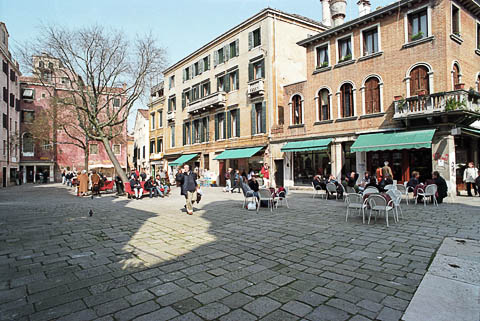 Campo Santa Maria Nova, Venice A busy neighborhood square. ©2001 J.Crawford Three new books are briefly reviewed. The first, Public Spaces, continues a tradition of small, pithy examinations of urban life and how to make it work better. They are coming out of Asia, principally Bangladesh.
You might consider buying a carton of these books to hand out to local officials who still don't have a clue what public space is all about. (It's not really their fault; many of them have never experienced a public space that works.) This book is not a planner's guide to public spaces. There's no math involved, no rigorous standards. Rather, this book seeks to show the reader how important public spaces are to quality of life and the strength of social connections in a city. It's an inspirational work, not a manual. It's nicely illustrated and printed in a handy format. The one possible stumbling block for North American use is that the book focuses mainly on southern Asia. The lessons, however, are timeless and placeless. This is a book to give to anyone with an open mind on the subject of cities. Have a look at the free download, link just above.
This book is a socio-economic study of the car in the USA. The authors, two sisters, were impelled to write the book by their own tragedies (five friends or family lost to car crashes). They went on to investigate the car as a major phenomenon in American life. They approached the study from a variety of viewpoints and conclude with some suggestions to Americans on how to reduce the stranglehold the car has on them. It calls for more sensible pricing of driving and better funding of non-automotive alternatives. It's a serious book and appears to have been carefully researched. It's depressing to read a book like this, mainly because the only possible conclusion is that any real change in the "American Love Affair with the Car" is going to be difficult, expensive, and slow. This not withstanding the increasing irritation with traffic. The "my car is me" phenomenon is so deeply rooted in so many Americans that a significant change in attitudes will require people to find new (i.e., real) identities for themselves. This will not be easy, quick, or painless. There is a lot of material on the economics of car ownership, the predations of car dealers, and the interplay between the car and society. All of it seems sound. Most depressing, perhaps, is that people spending hours in their cars listen to the likes of Rush Limbaugh, which makes any change in the status quo even less likely than it might otherwise be.
This disappointing work does not even have the word "carfree" (or any of its variant spellings) in the index. A quick thumbing seems to show that the topic is not in the index because it's not in the book. Even though these folks understand that catering to the automobile has nearly destroyed American cities, they still cannot bring themselves to call for even small carfree spaces at city centers. Given that Europe has been installing them for decades now, with excellent results, it seems strange that American practitioners in the forefront of urban planning still will not utter the word. They must be awfully scared. This is a small book that condenses each topic into onto one (sometimes not even full) page. It's nicely illustrated and reasonably printed. It doesn't even cost much if you buy it at a discount. I fear, though, that most readers of this newsletter will not find much to interest them here.
The Miami Herald sees it differently. Read their article, Architect's urban living guide doesn't include cars." Huh?
Hot New LinksThe links below will open in a new browser window:
First images: Foster's vision for Masdar City takes shape Hong Kongís marvellous transit system Twelve Anti-Transit Myths: A Conservative Critique [PDF!]
About Carfree TimesNext IssueThe next issue of Carfree Times is scheduled for May or June 2010.
Subscribe to Carfree Times
Write for Carfree Times
|
| Editor | J.H. Crawford |
| Send e-mail | |
| URL | http://www.carfree.com/
|
Back to Carfree.com
Carfree Times Home
Back to Carfree Times Issue 56
Forward to Carfree Times Issue 58
E-mail
carfree.com
Copyright ©2010 J.Crawford
